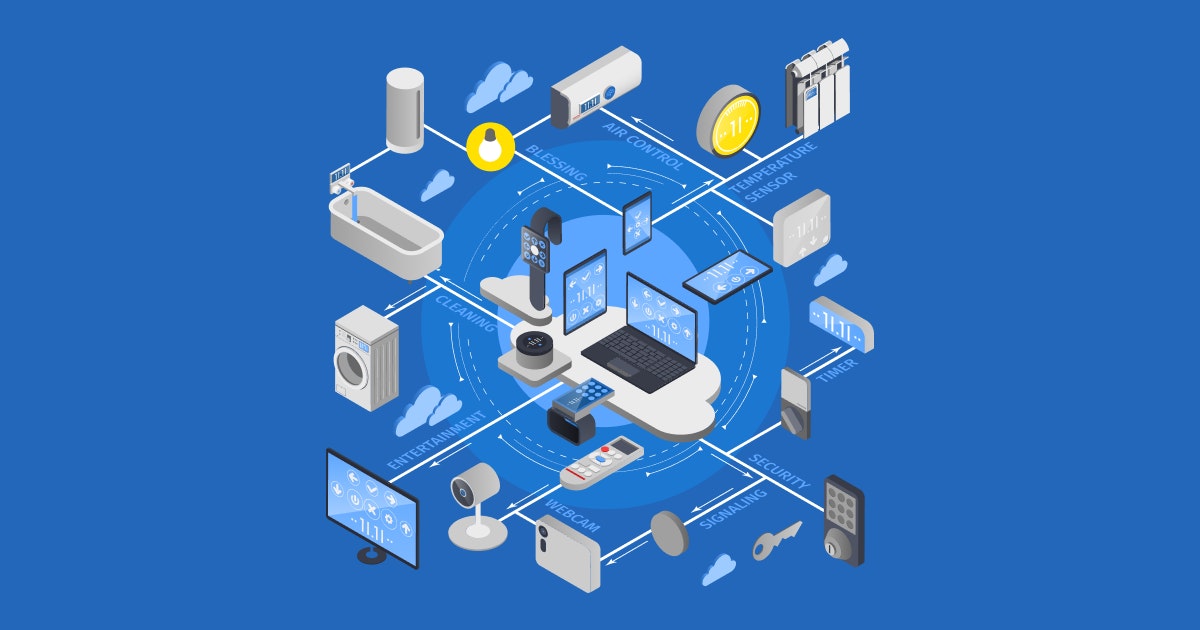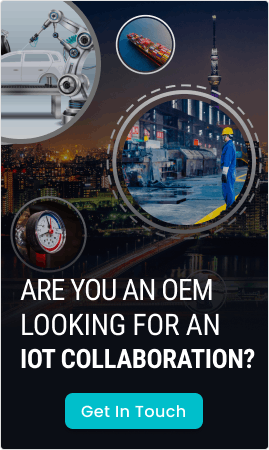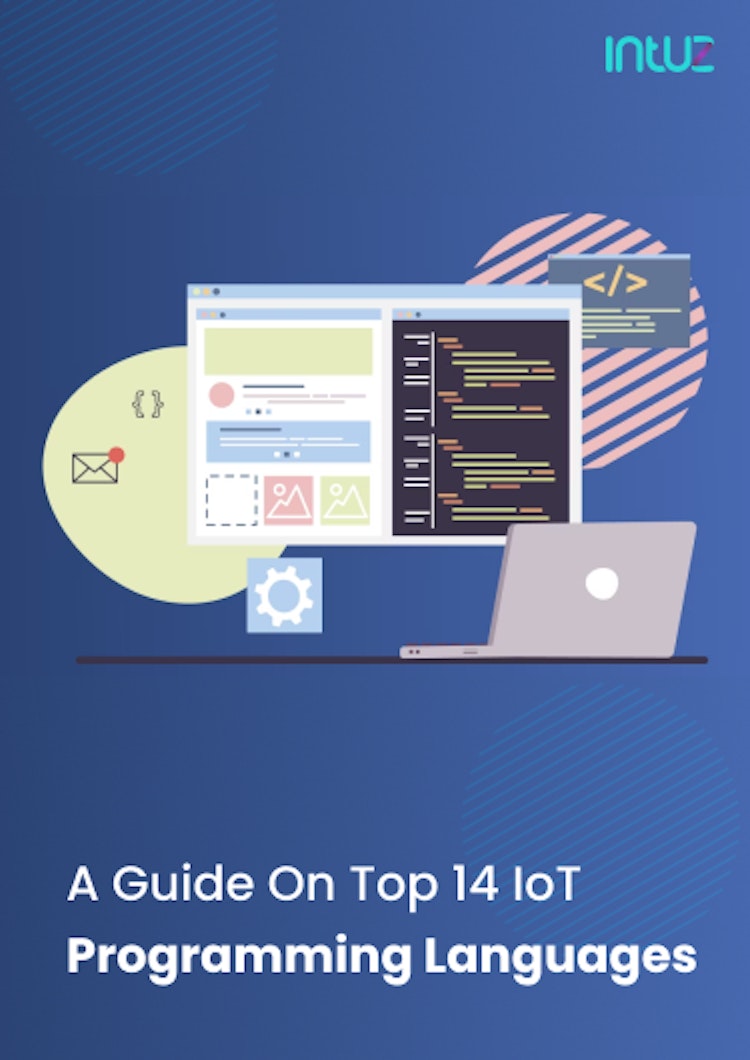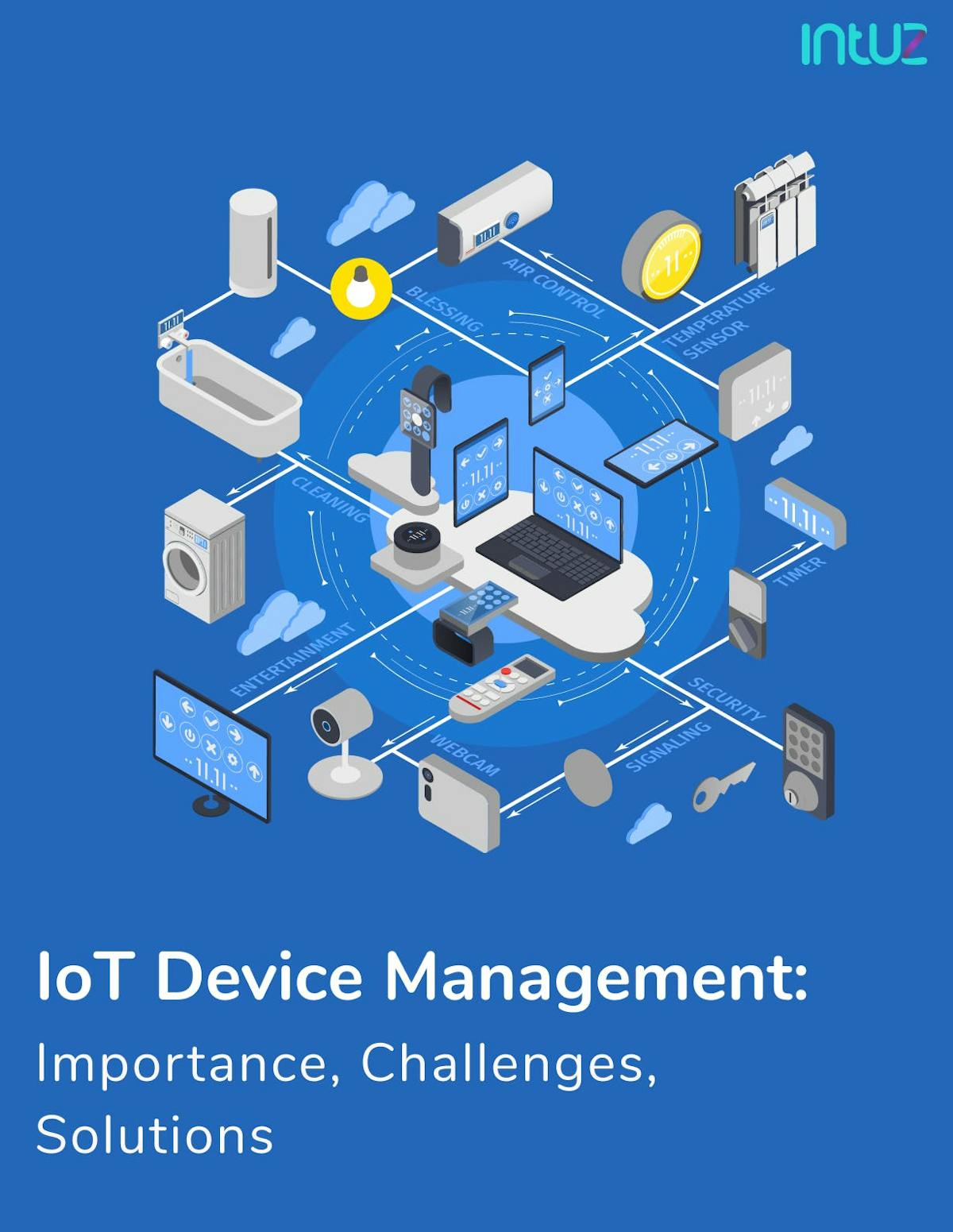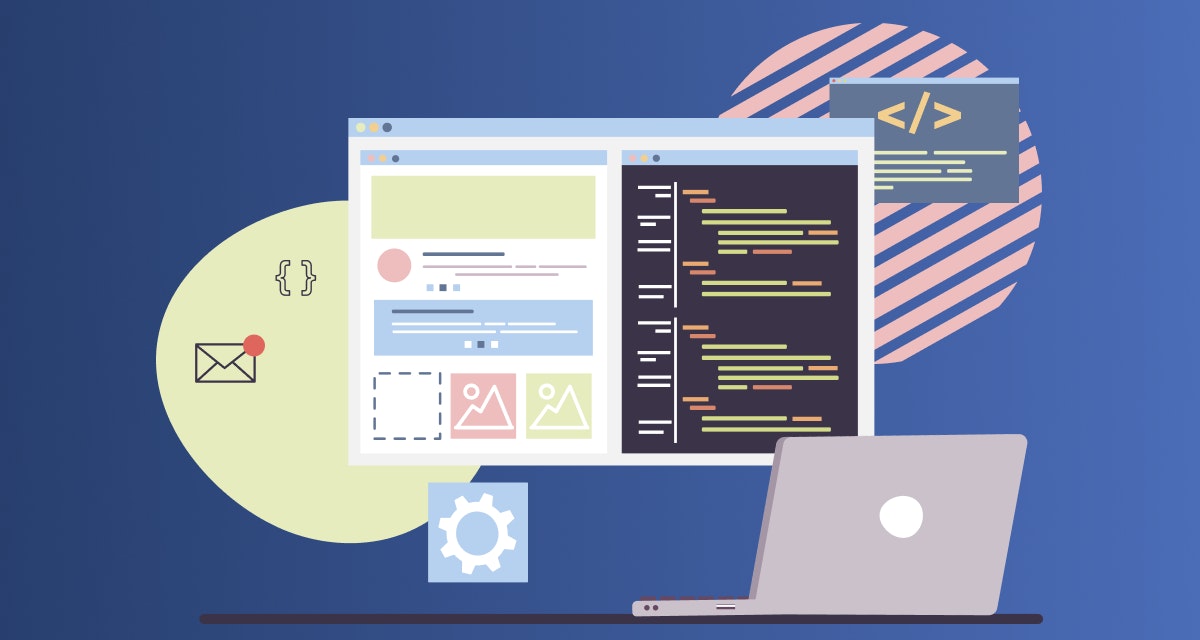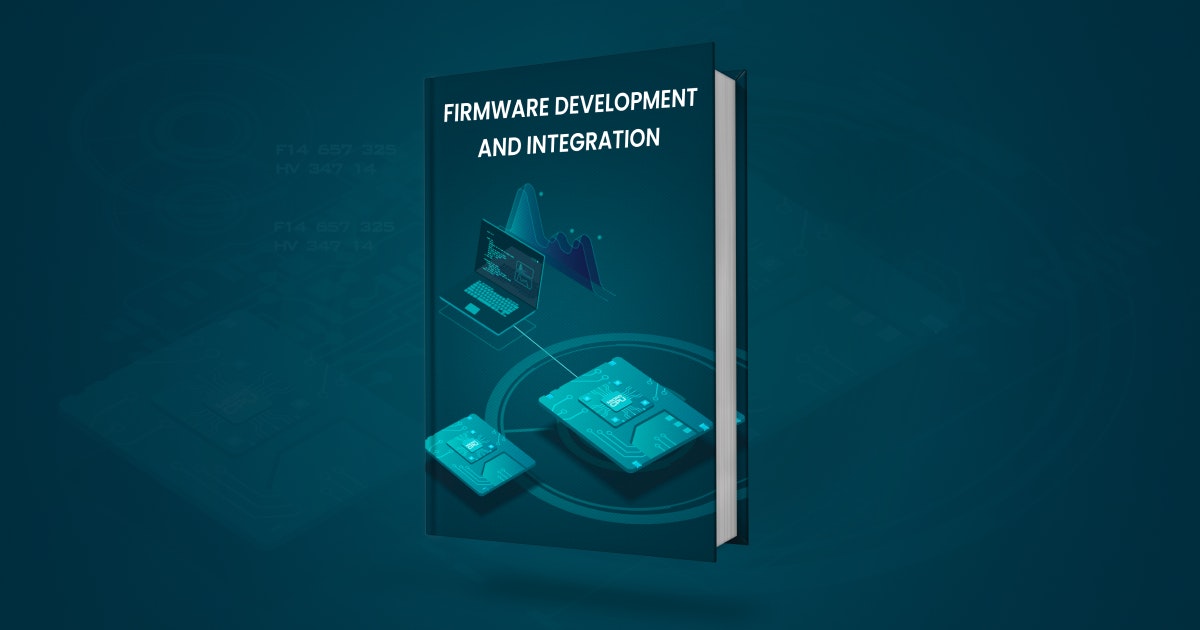Table of Content
As the concept of the Internet of Things or IoT continues to expand rapidly, the need for services spanning multiple IoT application domains will also increase to realize the efficiency gains promised by IoT technologies.
However, today, the majority of IoT app developers are looking to add value to existing IoT systems and, hence, deal with heterogeneous systems and devices.
IoT networks comprise several heterogeneous devices connected with each other that deploy diverse protocols (standards or proprietary-based), communication techniques, and network connectivity options, playing a critical role in the infrastructure.
IoT device management facilitates interactions among these devices and allows you to monitor your entire network conveniently and hassle-free. It enables remote handling of devices and offers insight for identifying maintenance requirements.
Managing IoT devices is crucial for the efficient performance of the IoT infrastructure and helps control costs. The following section will look at how to manage your remotely-connected devices best. We will explore examples that illustrate the correct and most efficient approaches to device management. Let us begin:
What is IoT device management?
IoT device management is checking and controlling your deployed IoT devices. It involves remotely accessing the IoT device to diagnose its health and manage its functionality.
Depending upon the size and location of your network, your devices may or may not be physically accessible. However, to ensure adequate performance and security of your IoT network, you must assess the capability of each of these devices regularly.
Staying on top of their performance levels is critical for maintaining their safe functioning and complying with regulations. IoT device management helps explain the vital importance of secure and high-quality tools to prevent problems and fix malfunctions.
It combines hardware and software solutions for end-to-end supply chain integrity control.
Transform Your Business with Custom IoT Solutions!
Explore SolutionsThe most prominent use cases of IoT device management
1. Smart home automation
Imagine a seamless symphony of connected devices - thermostats adjusting temperature, lights responding to your presence, and security cameras sending real-time alerts. Device management empowers this by facilitating:
- Remote control: Adjust lighting, thermostats, and appliances from anywhere.
- Device health monitoring: Ensure all smart devices are functioning optimally for a smooth user experience.
- Security updates: Deploy critical security patches to safeguard your smart home network.
2. Industrial IoT (IIoT) predictive maintenance
In industrial settings, sensors monitor machinery and equipment health. Device management empowers:
- Real-time monitoring: Track performance metrics and identify potential issues before they escalate into downtime.
- Predictive maintenance: Analyze sensor data to predict equipment failures and schedule preventive maintenance, maximizing uptime.
- Remote configuration: Update device settings and configurations over-the-air for efficient operations.
3. Healthcare and remote patient monitoring
For improved patient care and reduced readmission rates, device management is crucial for:
- Remote monitoring: Track vital signs of patients in real-time, enabling early intervention.
- Data collection and analysis: Gather and analyze patient data from wearable devices for personalized healthcare plans.
- Device security: Ensure patient data privacy and security with robust access controls.
4. Smart cities
From optimizing traffic flow to managing waste collection, device management plays a key role in smart city initiatives by:
- Connected infrastructure: Manage traffic lights, parking meters, and environmental sensors for efficient city operations.
- Data-driven decisions: Collect and analyze real-time data to make informed decisions on resource allocation and city planning.
- Citizen engagement: Enable citizens to interact with city services through connected devices, fostering a more responsive environment.
5. Fleet management
Device management empowers fleet operators to:
- Real-time tracking: Monitor vehicle location, fuel efficiency, and driver behavior for better route optimization and cost savings.
- Predictive maintenance: Identify potential vehicle issues proactively, preventing breakdowns and ensuring safety.
- Compliance management: Ensure vehicles adhere to regulations with automated reporting and alerts.
6. Agriculture and precision farming
For increased crop yield and resource optimization, device management empowers:
- Environmental monitoring: Track soil moisture, temperature, and other factors for data-driven irrigation and fertilization.
- Livestock monitoring: Monitor animal health and optimize feed management for improved well-being and productivity.
- Equipment management: Schedule maintenance for farm equipment based on real-time data to avoid downtime during critical periods.
7. Retail and inventory management
Device management helps retailers:
- Real-time inventory tracking: Gain real-time visibility into stock levels, preventing stockouts and optimizing ordering.
- Asset tracking: Track the location and status of inventory throughout the supply chain for efficient logistics management.
- Loss prevention: Monitor inventory movement and identify potential theft or shrinkage issues.
8. Energy management
Device management empowers businesses and households to:
- Remote monitoring: Track energy consumption from smart meters and connected devices for informed usage decisions.
- Demand response management: Optimize energy usage based on real-time grid conditions and pricing.
- Predictive maintenance: Identify potential issues in energy infrastructure for proactive maintenance and reduced downtime.
9. Connected cars
Device management unlocks the potential of connected cars by:
- Remote diagnostics: Diagnose vehicle issues remotely for faster repairs and improved safety.
- Over-the-air updates: Deploy software and firmware updates to connected cars for improved functionality and security.
- Usage-based insurance: Enable personalized insurance plans based on real-time driving data.
10. IoT gateways
As the central hub connecting devices to the cloud, device management ensures:
- Secure communication: Enable secure communication between devices and the cloud platform.
- Device onboarding and configuration: Simplify adding and configuring new devices to the network.
- Data pre-processing and filtering: Process and filter sensor data before transmission to the cloud for efficient data management.
Examples of IoT devices
The below examples highlight specific IoT device management solutions across industries, showcasing their functionalities and benefits in real-world applications.
1. GE Predix
An industrial IoT platform that manages and analyzes data from industrial machines to optimize performance and predict maintenance needs.
2. Omron's health monitoring IoT devices
Wearable health monitors that track blood pressure, activity levels, and sleep patterns, transmitting data to healthcare providers for remote patient monitoring and personalized care.
3. Sigfox
A low-power wide-area network (LPWAN) solution that enables IoT devices to communicate over long distances with minimal energy consumption, used in asset tracking and smart city applications.
4. Cisco Kinetic
IoT operations platform that connects devices, extracts data and automates workflows to improve asset management and operational efficiency in smart cities and industrial environments.
5. Helium
A decentralized IoT network that enables low-power, long-range wireless communication between devices, used for asset tracking, smart agriculture, and environmental monitoring.
6. Samsara
IoT fleet management solutions that use real-time data from vehicles to optimize routes, monitor driver behavior, and improve fuel efficiency and safety.
7. SmartThings
Samsung's IoT platform connects and controls smart devices in homes, allowing users to manage lights, appliances, and security systems from a single interface.
8. Bosch IoT Suite
A comprehensive IoT platform offering services for device management, data analytics, and software development, used in smart manufacturing, connected mobility, and smart homes.
How to control and manage IoT devices?
The fundamental tasks of an IoT gateway device management system are to integrate a new device into the network, monitor its ongoing health, and ensure uptime. The steps involved in this process are:
1. Provisioning
The device provisioning process is a critical step in IoT management. This phase includes setting up your account and authenticating it. The device settings are also customized to ensure that the newly installed software on any given hardware works as expected for its intended purpose. It helps connect the device seamlessly to your network.
Provisioning refers to the modifications made to the device to make it compatible for integration with your network. An IoT remote manager takes the pain out of managing your IoT devices by zero-touch configuration. It helps speed up on-site installations.
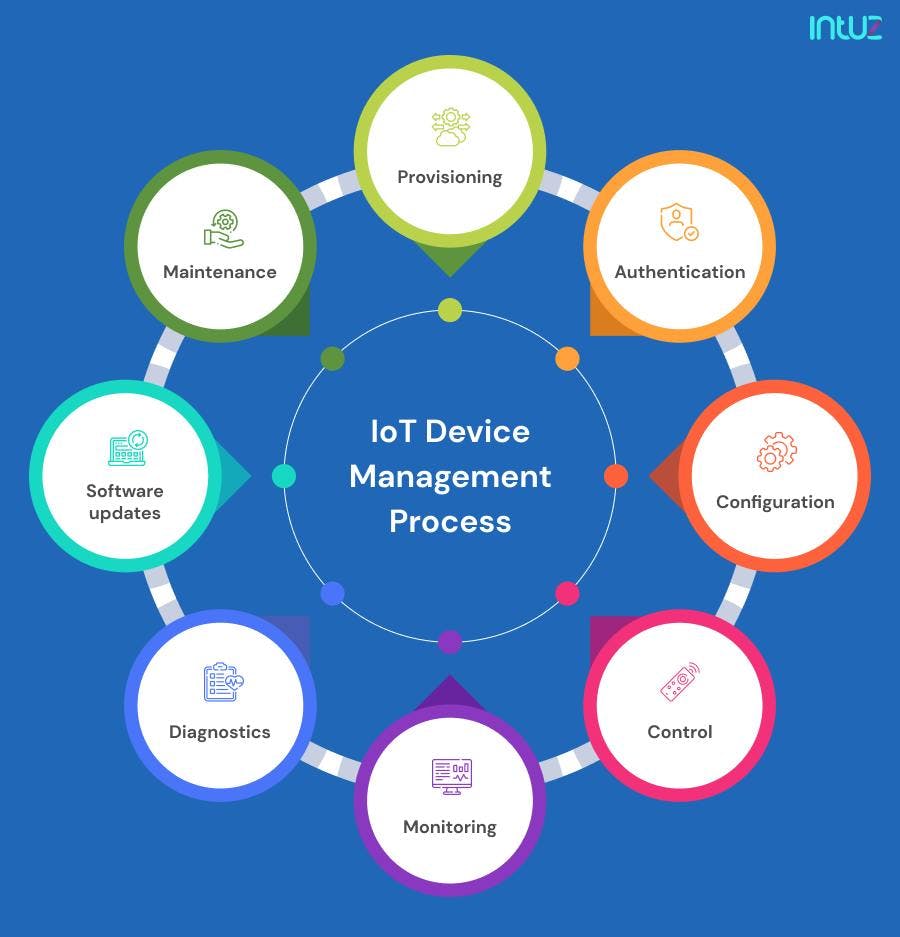
2. Authentication
The process of verifying a device's identity as it is enrolled in the IoT system and authenticating users at login is called authentication. IoT device identity management and authentication assure that only authorized devices are enrolled on the network, so any intrusions can be prevented.
Authentication enables administrators to establish device and network security settings so that access attempts can be authorized or blocked. Properly managing these networks helps keep your company's proprietary information confidential while also ensuring the security of each user who connects through them.
3. Configuration
IoT configuration management is a way to customize the functionality of your IoT device. You can add additional sophistication and intelligence by writing custom code or revising settings for new requirements with ease.
It is essential because your requirements may change over time, and you may need to add new features or change device settings. IoT device management tools help you manage all aspects of configuring devices and gateways on networks.
They allow you to quickly and easily configure any number of devices, even if they were all initially provisioned with the same functionality. In case of a breakdown, you can modify the devices remotely so everything works properly again.
4. Control
All devices that are successfully authenticated, configured, and installed on the network will be able to communicate with their peers automatically. The behavior of devices is defined during the provisioning and authentication phases.
But sometimes, you might need to control the IoT device and even override the rules set out during provisioning. It can be helpful in cases where you may need to control automated processes for a short period of time, reboot devices, change device settings, and optimize device performance.
The availability of IoT device management systems allows you to control the functions of connected devices remotely. Remote access to devices across the network enables them to take appropriate action when needed and optimize their performance by altering configurations or software updates.
5. Monitoring
With IoT device management, you can keep track of your internet-connected devices from anywhere. Whether for security purposes or monitoring equipment health, remote IoT device management helps you meet your needs. Other objectives are:
- System metrics: Get a real-time view of your network with customizable alerts and statistics so you can keep an eye on everything happening across the IoT network. You can see all updates regarding the performance of each device on a single dashboard and keep track of all events occurring within your IoT network.
- Data reporting: Driven by machine learning-based applications, data reporting offers critical insights on user-defined data points. These can include measurements derived from data collected by the sensors, such as tank levels or the temperature of a material.
- Notifications: To avoid a system failure that could lead to data loss or performance degradation, notifications must be set up for any changes made across the network. Administrators can use these user-defined alerts to make critical decisions about what actions need to be taken to get things under control.
- Security: The ioT device management platform allows you to detect and fix any security breaches. For instance, if an attacker tries changing the configuration on one of your devices, you will be notified. It is crucial as you can take action before they succeed in their attempt.
6. Diagnostics
The IoT device management platform enables you to perform diagnostic tests on the entire network or an individual device. These diagnostics help you detect and quickly troubleshoot issues, thereby minimizing downtime.
A regular check of the network helps with preventive maintenance, reducing the repair cost and impact of device failure. The benefits of remote diagnostics include rapid identification and remediation of any network or device issue.
It even allows you to access offline devices while saving time and money. Besides being convenient, it ensures the security of your IoT infrastructure.
7. Software updates
As IoT devices become more intelligent, they also feature more complex software-defined attributes. Software is the lifeline of an IoT device, as it establishes its role in the network. It helps enable edge computing functionality and prevents viruses or cyberattacks at the endpoints.
The need for wireless network administrators to be able to send firmware updates across an entire IoT device fleet is imperative. There are different types of software updates, like updating new features, installing manufacturer-provided enhancements, or fixing bugs in the system.
Security patches ensure that your devices remain secure while updating the code to adapt them to perform better and meet ever-changing business requirements. IoT device management platforms help perform these updates without disrupting normal operations.
8. Maintenance
The most critical aspects of managing IoT devices are maintaining visibility across all your deployed hardware, getting notified of any issues, and troubleshooting them. Not only will you need to be able to tackle any problems that arise, but updates are inevitable over time as well.
As some of the devices may last decades, you will need to update their firmware with feature enhancements or security patches.
Device maintenance is an essential part of keeping your devices up-to-date with the latest software, and it goes hand in glove with monitoring. The IoT remote manager takes care of your device's maintenance needs over time.
They provide ongoing device diagnostics and remote access to perform updates based on analytics. Avoiding these crucial steps may lead to erroneous device deployments, lapses in security, and falling out of compliance.
An efficient IoT device management platform and a well-thought-out strategy help perform the above-listed tasks. You can even automate routine maintenance activities to cut down on manual checking or set up auto upgrades to ensure all devices are up-to-date at all times.
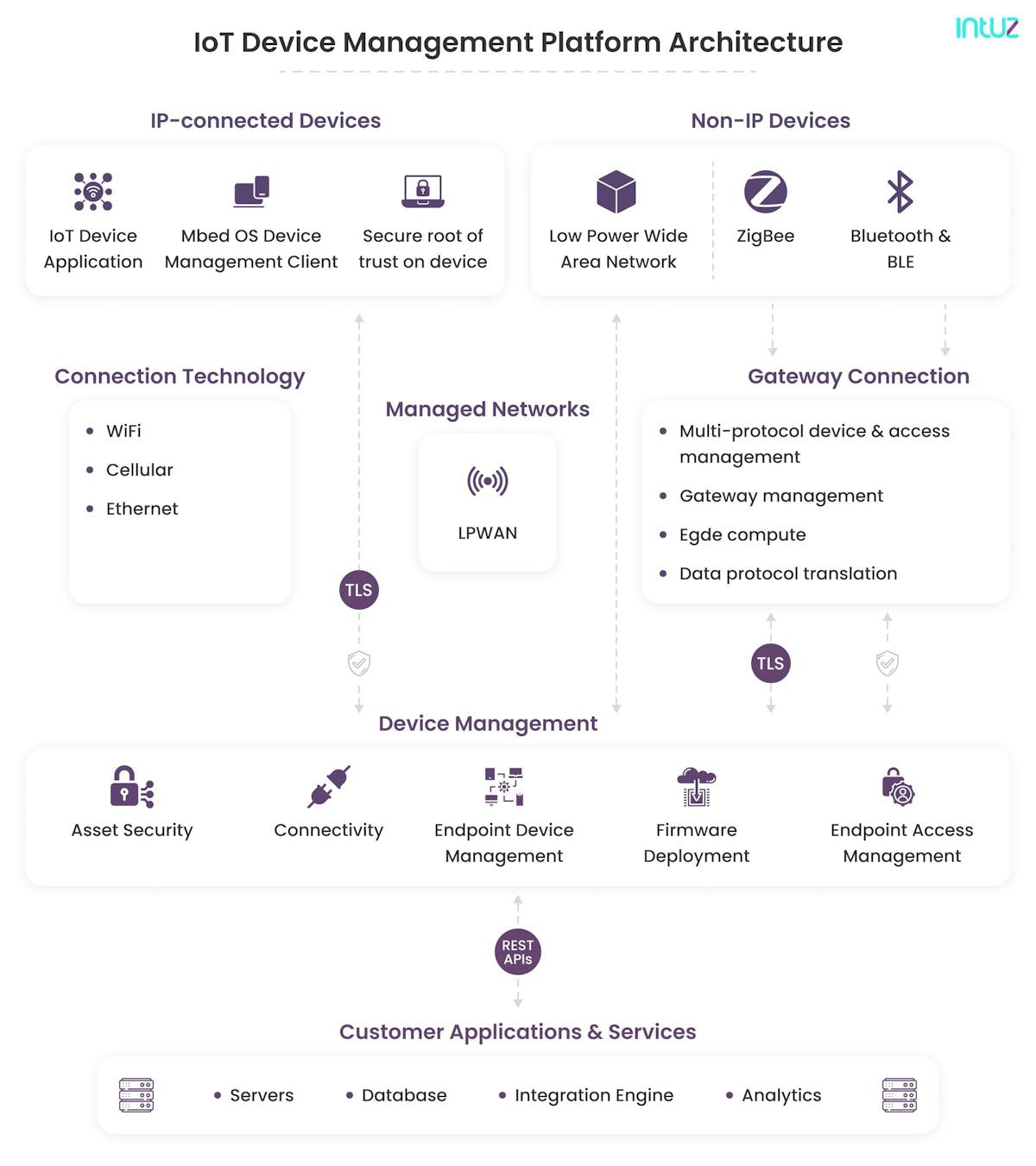
IoT device management
Benefits of IoT device management
Once you have planned your IoT strategy, you are better positioned to identify the right IoT device management platform for your business. It would help if you looked for a management solution that delivers the following benefits to generate reasonable ROI from your IoT investment:
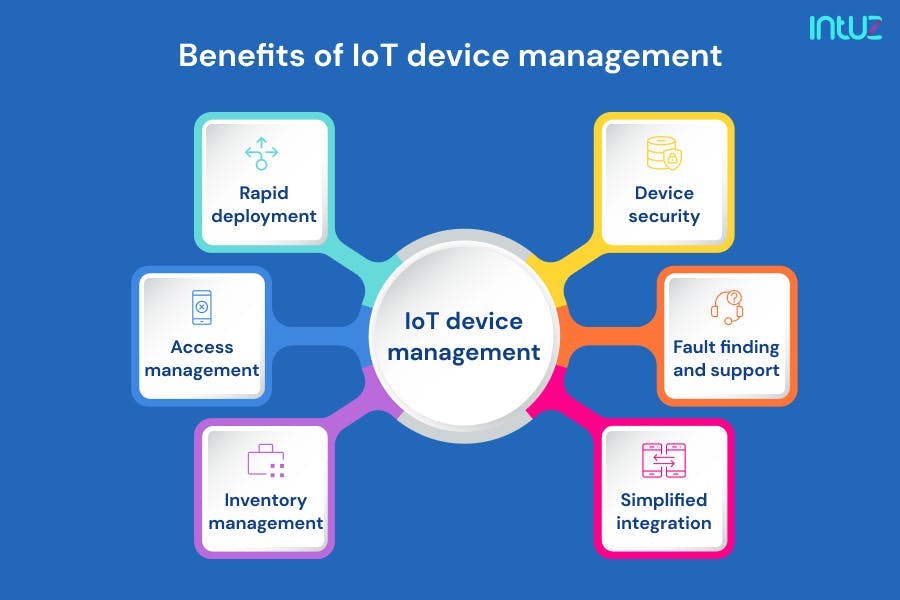
Benefits of IoT device management
1. Rapid deployment
The rise of new technologies requires additional technical personnel to deploy them and train staff to use them. This involves high costs, especially when deploying devices in other countries or areas with strict regulatory policies.
Though it is great to improve the efficiency of your staff, ensuring data security is tricky. Pick the device management platform that empowers you to ship IoT hardware anywhere globally and easily configure them remotely.
The right choice will help save the cost and time required to arrange on-site technical staff. You can remotely control the device and bring it back up instantly in case of malfunction.
The 'zero-touch' configuration method offered by some vendors is an easy way to get your devices up and running. The hardware is programmed to automatically configure the pre-defined settings once it connects to the internet.
Since the device configures itself to the chosen settings for firmware or applications, it can be easily installed by anyone with minimal technical knowledge.
A Guide On The Top 17 IoT Operating Systems For IoT Devices
Learn More2. Access management
There are many ways to keep your company's data safe, but sometimes it can be difficult when multiple remote devices collect data. To mitigate any cyber security risk in such networks, you must have complete control over all physical devices and ports.
The device management platform enables you to take control of your data by creating authorized users on the system. You can then limit or grant access rights for core functions and activities from a central location.
It helps you keep track of any potential security breaches and protect confidential information like passwords or usernames. It triggers an alert in case of a security breach and allows the authorized personnel to take action.
You can choose to change your password, remote access, permanently block suspicious accounts, and keep your IoT network safe and sound.
3. Inventory management
The challenges of managing data from thousands or even millions of devices can be an overwhelming task. Manually collecting and storing data may lead to duplication and data silos. Such data is not helpful for the improvement of business operations.
In fact, it also leads to data shifting and a rise in the number of orphaned devices. Device management platforms resolve this by providing an additional layer in which all deployed equipment is recorded with their firmware, installed applications, and configuration.
This makes it easy to find the data when needed. Some platforms even include geographic mapping options so users can pinpoint their surroundings using either GPS signals from satellites or cell tower triangulation.
4. Device security
A Gartner survey report shows that nearly 20% of organizations have been subjected to at least one IoT-based attack. As hackers constantly try to access your devices, security flaws in operating systems or edge applications make the entire network vulnerable to cybercrimes.
The goal of security in an IoT ecosystem is to keep your devices safe to do their job properly. This requires updating software and firmware on time, usually done by flashing new updates from a computer connected via USB or Ethernet cable.
However, with IoT Over-The-Air (OTA), you do not need a computer to share the latest patches. Instead, it can be done directly using just the WiFi connection.
The device deployment tool lets you update firmware, applications, and configuration files remotely on a per-device basis and with groups of devices. This makes securing thousands of IoT devices across various locations easy and instant.
5. Fault finding and support
You must keep an eye on the performance of your devices as they grow in number. You must monitor their status more frequently to look for warning signs even before problems arise. It is necessary as an issue with one particular device can cause a service interruption throughout all networks.
An effective dashboard and alerting system is best to keep a tab on your expanding device fleet. Device management platforms offer essential tools that provide live updates on the status of your devices.
When the platform triggers an alert, you can diagnose issues quickly and accurately. Generating reports will give clear insights into the cause of problems in the production systems or networks. Using the detailed information, you can set rules to resolve them or try to fix them remotely automatically.
6. Simplified integration
Data collected by IoT devices is stored and analyzed at various locations. Your IoT device management software must be interoperable to ensure enough communication between deployed devices and platforms.
OpenAPIs will seamlessly integrate with most software platforms and IoT management systems. Some environments offer specific integrations into approved third-party domains, such as Microsoft's IoT hub.
The arrangement allows you to easily connect your sensors with third-party software and use their data to generate insights.
Why do IoT devices matter?
IoT has been a popular topic for decades now, and we are still not entirely sure what it will look like in the future, but there have nonetheless been many advancements.
One particular example is how appliances can be connected. When one runs out or needs maintenance, they all receive notifications from their respective networks telling them about any issues at hand.
Though the IoT has not quite reached the point of being globally applicable, it is steadily evolving. While the concept itself does not have any significant flaws, rapid growth, and technological adaptation limit how much of an impact this technology can make in our lives right now.
Innovations must come for them to succeed today and tomorrow when things might change. When it comes to IoT device management, you cannot underestimate the power of familiarization.
A sturdy and steady evolution in this area will be vital for bridging any gap between growth expectations that may seem too high and reality when large-scale IoT projects fail.
Innovations will only make their mark if stakeholders are aware of the IoT applications and device management software beneficial for their businesses. It will help make informed decisions among the available software solutions.
IoT device management fundamentals
IoT is a vast and ever-growing landscape. It is essential to follow certain best practices for how connected devices are managed. These fundamentals facilitate decision-making within an IoT project and give a broader awareness of what happens throughout a connected device's lifecycle. Adding to that thought, here is what the device life cycle comprises:
1. Onboarding
The deployment of billions of devices worldwide is an exciting new frontier for IoT technology, but it starts with the critical step of enrollment into the system. This process helps accelerate time-to-market and bypass risks related to hostile cyberattacks.
If not done correctly, device onboarding can severely affect the project's success. One of the most critical aspects of provisioning IoT devices is device authentication. This process establishes a secure connection between the IoT device and device management platforms.
It involves sharing device credentials with the server. In case the device is trustworthy, it receives further configuration data. You may deploy authentication methods such as device certificates or pre-shared keys to ensure secure connections between them.
This step is necessary to prevent hackers from accessing information being shared across the network. Each time a new device tries to establish a connection, the device management software must ensure proper authentication before allowing the connection request.
2. Configuration
The process of onboarding new IoT devices can be challenging, as they need to have their resources allocated immediately.
This means that in most cases, smart sensors or other internet-connected gear come with preconfigured settings provided by manufacturers, which may or may not meet your specific requirements for deployment, such as where you want them installed and what role the device will play within an emerging ecosystem framework.
The key to managing your IoT fleet is understanding how it will behave when new devices are introduced. Each device must perform exactly as it is intended to, even in the presence of a new device. But there also needs to be a flexible configuration mechanism so that device behavior can be tuned in real-time.
For instance, if something goes wrong with any deployed systems, the remaining devices must take over immediately to prevent the entire IoT network from collapsing.
This can be easily implemented by grouping your devices to save your effort in adjusting device settings manually. Since the group automatically detects anomalies, it prevents mistakes, and the custom solutions are immediately deployed using remote tools.
3. Diagnostics
The diagnostic features of an IoT device are often overlooked, but they play a crucial role in reducing downtime. They can help identify bugs or operational issues before these problems impact your business operations.
The goal of diagnostics is not just to monitor network statistics and detect any security breaches but also to prevent failures from happening or counteract them before they become harmful to your IoT device or the overall network.
IoT device management software uses sophisticated IoT analytics mechanisms for generating valuable insights on when to expect any operational issues so that you are prepared to deploy preventive measures if necessary.
4. End of life management
Upon completing the above steps, your IoT fleet is set up and running smoothly. You only need to keep its firmware up to date to fight against any hacking attempts or random failures as it is properly configured.
You must also ponder over one inconspicuous yet fundamental aspect left for consideration at this stage. You must think about what will happen after successfully completing a project or when a single device reaches its end of life.
Managing the end of life for smart devices is essential for protecting data and systems from being compromised. To do this effectively, you must have a plan that ensures all relevant information about these technologies is adequately decommissioned.
Doing so will ensure they do not pose any further risk or vulnerability when replaced with new ones during their phase-out process.
Other key considerations
The above-outlined phases are not just guidelines for IoT deployment and growth. Instead, they can be significant challenges on your journey. Each of these is crucial for the successful implementation of an IoT system.
You must ensure your IoT system is well-protected and reliable. The connected devices on your network must be interoperable and scalable. A well-designed IoT device management software is the key to integrating, organizing, and monitoring devices throughout their lifecycle.
It helps you remotely manage the fleet of sensors in your IoT landscape without sacrificing security or functionality.
Device management is not only about the infrastructure, connectivity, and software used to operate the connected devices but also considers keeping your network up-to-date with current IoT protocols.
The platform you use must adopt widely accepted industry standards for life cycle maintenance, including tracking the performance and power levels of your IoT assets, among other tasks.
IoT protocols such as Lightweight M2M offer a way for devices to communicate with one another without relying on any centralized system. This prevents them from being susceptible and exposed, thus protecting their users' privacy while also ensuring they are up-to-date to mitigate all security threats.
When to use IoT device management?
The IoT device management service is a must-have for any company that deals with many devices. This includes industrial, consumer, and commercial applications alike.
The benefit of using IoT device management for your devices is that you can manage large and diverse fleets such as operational technology systems, cameras, appliances, and vehicles.
1. Industrial applications
IoT device management makes it easy to connect, monitor, and troubleshoot devices across your industrial site fleet. You can view usage metrics for each domain on one dashboard. The cloud-based service allows you to manage your devices remotely and provides insight into their configuration.
With the ability to monitor changes in metadata and policy, the alerting system ensures you get the relevant information in time for adjustments. AWS IoT Device Defender, for example, is a tool that can be used to audit and detect any unusual behaviors across your fleet. You can take mitigating actions remotely, such as deploying fixes.
2. Consumer applications
With IoT device management, you can now control the deployment speed of your Over-The-Air (OTA) updates to consumer devices such as connected light bulbs or WiFi routers.
You can send an update to ensure devices are running the latest software and push bug fixes or firmware updates so all devices are always up-to-date. You could also automate downloading new releases on the first activation, giving your company more control over firmware updates.
3. Commercial applications
IoT device management simplifies the management of your device fleet by allowing you to group them into a hierarchical structure based on function, security requirements, or any other category that best suits your business needs.
You can have different categories for each level within the hierarchy. For instance, you can group all sensors in one room together and create groups of rooms on floors as each has a similar purpose.
With fleet indexing, you can keep an eye on the state of any connected device and take actions across multiple devices at once. You will also be able to use bulk registration for quick registrations of a fleet of new devices.
Integration with cloud platforms and business processes
IoT applications provide critical data to network operators, analysts, and business decision-makers in your organization. To ensure that the IoT applications are delivering on their promise, they need to be designed with an intelligent device management platform.
Your IoT application, for instance, should be capable of integrating seamlessly into third-party cloud providers such as Amazon Web Services or Microsoft Azure, and Google Cloud.
With the help of IoT device management protocols and web services such as MQTT and HTTP, it is possible to monitor your devices remotely. An efficient device management platform uses a RESTful web services interface to integrate with third-party services.
It offers real-time business intelligence by facilitating connectivity between edge devices such as cellular routers and gateways. You can easily install updates and code from third-party applications on all deployed devices in your network.
A high-end management platform can also facilitate the seamless migration of your IoT deployment to a new third-party cloud application.
Contextual IoT device management
IoT technology is all about connecting devices to networks for varying objectives and to meet different requirements. As the number of devices on a network increases, so does its capability and need for targeted performance.
You can expect sophisticated functionality from those complex connected systems. Contextual device management focuses on addressing specific needs that a business expects from a network platform.
An intelligent platform allows you specific control over how each application functions within your large-scale or complex network. The different types of data sets collected by these devices must be sent to different users so that they can use them for specific purposes.
Here are a few examples of how contextual IoT device management is essential for projects with varying data needs and device functionalities:
1. Agriculture
The sensors on farming equipment must deliver data such as temperature, moisture conditions, and location of vehicles or portable irrigation systems as they change. This real-time information helps in taking preventive steps before the damage is caused.
2. Solar systems
Solar panels are fixed and do not move geographically. Still, they must be able to adjust their positions according to the changes in the weather and the sun's position for maximum output.
3. Electric vehicle charging
Integrating EV charging stations with applications can help drivers find their nearest station and monitor power usage easily. They may also receive real-time information about their vehicles, such as their energy consumption or whether they need servicing.
Capabilities and limitations of essential IoT device management
The IoT technology offers an incredible new way to have more control over your business. However, managing the growing number of devices as you scale can be difficult.
Basic IoT device management simplifies the process by allowing you to manage standard functionality requirements for most applications. It simplifies connecting or disconnecting from networks. Here is a list of capabilities and limitations of basic IoT device management:
1. Range
The ability of an IoT device to communicate with other applications is often dependent on two factors: power management and antennas. The built-in features of an application can control power management.
However external components such as an antenna can be added or removed as needed for varying ranges. With the right IoT device management tools, an organization can easily test and monitor the app's range.
2. Bandwidth
Bandwidth in an IoT application is determined by the type of modem on your device and your network availability. You may pick a suitable modem from 3G, 4G LTE, or 5G. But if there is no coverage where you deploy your devices, it is impossible to establish a connection even with high-end capabilities. However, contextual tools provide visibility across the network and allow you to test bandwidth so that administrators can make decisions accordingly.
3. Battery life
The battery life of your IoT device is a function driven by two things: the device design and its application. The battery will be used based on the kind of application that has been installed onto the system.
For instance, sensors placed in an oil well will use some power from the battery each time they send data. You must, therefore, decide the frequency of data needed to optimize battery usage.
Edge computing techniques and advanced device management solutions are becoming increasingly popular to optimize such processes.
Smart management of your IoT devices
IoT device management is a critical component of your planning, regardless of whether you want to build a brand new IoT project or upgrade your existing device network. The management of devices must also be included in your plan of action.
An IoT device management platform can perform functions like device onboarding, monitoring, and updating remotely. It provides access to critical monitoring and management tools that can save your time and reduce costs while improving security.
The platform understands your specific needs and aids in keeping your devices online, up-to-date, and optimized at all times. The features offered by an excellent IoT device management solution can generate a good ROI alongside the usual operational benefits.
Overview of IoT device management platforms
IoT device management platforms are also known as connected device platforms. They enable the remote management of a fleet of IoT devices and help your business onboard new devices by provisioning and authenticating them on the network.
Once authenticated, IoT device management platforms remotely configure authorized devices. They also monitor data collection and reporting, along with real-time updation of devices with Over-The-Air (OTA) software deployment for patches.
Such platforms help manage the IoT device through its entire life cycle, including offboarding upon project completion. Automated functions and security features are critical factors in IoT device management platforms.
They aim to make your network's daily tasks automatic, like adding or updating devices. The arrangement is specifically helpful as you scale to a larger number of devices. Automation minimizes the need to manage each device manually, which can become tedious.
IoT device management platforms add a layer of security to your IoT network and secure both individual devices as well as prevent others connected to it from being impacted.
IoT device management platforms provide a single access point for managing all your connected IoT devices. These centralized systems have many benefits, such as increased scalability and efficiency improvements that can be made through automation across various types of vendors and varying hardware types across several locations.
Best IoT device management software/platforms/tools
AWS IoT Core, Microsoft Azure IoT Hub, and Google Cloud IoT Core are among the top IoT device management platforms, offering scalable solutions for connecting, managing, and securing IoT devices across industries globally.
- AWS IoT Core
- Microsoft Azure IoT Hub
- Google Cloud IoT Core
- IBM Watson IoT Platform
- Cisco Kinetic
- Bosch IoT Suite
- ThingWorx (PTC)
- GE Predix
- Oracle IoT Cloud
- Siemens MindSphere
Factors to consider for choosing IoT device management platform
It would help if you considered these factors when comparing IoT device management platforms for your business:
1. Device compatibility
Compatibility is an essential factor when deciding on your network's IoT device management platforms. It depends on which IoT devices you intend to use, as most platforms work with common types of IoT devices.
However, some platforms are universally compatible, so you should evaluate your current and future needs before making a purchase decision. The device management software you select must demonstrate support for your devices.
2. User accessibility
When considering the accessibility of IoT device management platforms, it is essential to look at both how easy and efficient the platforms are in addition to the coding skills required to use them. Features of platforms that require less coding knowledge are more likely to be fully utilized.
3. Open-source vs. paid
Open-source platforms are popular in IoT management, as in-house customization is required under most circumstances. However, support may cost extra for open-source platforms, but it is usually available with paid platforms. Open-source platforms may also not be up to date with the newest advancements or improvements. You must decide between the two based on your business requirements.
AWS IoT device management: What you need to know
To ensure the success of your IoT deployment, it is essential to track and manage connected device fleets. You need secure access control for these devices, monitor their health closely to detect problems before they become severe, or even remotely troubleshoot issues if necessary to ensure minimal downtime on business operations.
By leveraging AWS IoT device management, you can register your devices individually or in bulk and easily manage permissions to remain secure. You will also be able to organize them for easier monitoring and troubleshooting across the network.
In addition, AWS offers convenient remote management capabilities, such as diagnosing an issue on a device online. Simply put, you can monitor and update devices from a remote location through an online portal.
AWS enables you to monitor device functionality with ease while you can send updates Over-The-Air (OTA) when necessary. All functions can be handled from a single dashboard.
AWS IoT device management service equips you to manage your IoT devices from the cloud. The management features are agnostic for device type and OS, making it easy enough to handle all IoT devices in a network.
You can also scale up this program by adding more sensors without doing any additional work on top of existing ones, thus allowing greater efficiency when tracking conditions like weather monitoring programs.
Benefits of using AWS IoT device management
AWS helps reduce cost significantly and allows optimization of resources as the processes are automated, requiring minimal human intervention. AWS IoT device management also brings the following benefits to the table:
1. Fast device registration
The AWS IoT device management service helps you securely add device attributes like name, type, and manufacturing year to the registry in bulk, making it easier for users. Using this cloud-based tool, you can also assign these settings to large fleets of connected IoT devices.
2. Simple IoT device organization
AWS IoT device management is a robust platform that lets you organize your IoT devices into groups and manage access policies. This makes it easy to track, operate or replicate business requirements by deploying firmware updates on all related equipment in one building.
You can create groups and apply access policies to these customized groupings, which will enable a flexible approach to tracking how they are being used while also giving proper care to their security needs. You can even create separate hierarchies of multiple sensors according to the vehicle type.
3. Locating connected devices quickly
The AWS IoT device management service is a must-have for any company that wants to take advantage of the growing IoT trend. The platform lets you easily search and find your devices across the network. It sorts the devices based on attributes such as device state, ID, and type.
4. Easy remote device management
AWS IoT device management provides a single, secure platform that streamlines your device management process. You can remotely update the software on devices after being deployed in the field.
Each device has access to the latest patches and updates to maintain its network's security. The built-in remote execution capabilities of the device help in simplifying tasks such as reboots or factory resets across an entire fleet.
Fleet Hub is an AWS IoT device management application that empowers your support technicians, field operators, and engineers to easily view all of their device fleets from anywhere. It allows them to interact with the devices securely and manage them more efficiently, thereby minimizing downtime.
How does AWS IoT device management work?
AWS IoT device management is a service that helps you register, organize, and monitor your devices in the cloud. It integrates with AWS IoT Core to make it easy for people across different networks or business units to manage their fleets remotely.
AWS IoT Device Defender helps you keep tabs on your fleet. It sends alerts if there are deviations from the defined behavior. You can use the AWS Management Console to mitigate actions such as pushing security fixes and ensuring all devices meet the same standards.
It also enables you to easily send Over-The-Air (OTA) updates to your AWS IoT Greengrass or FreeRTOS devices, such as the latest software version for one of these platforms.
Customized Industrial IoT solutions. Get in touch!
Explore NowOver to you
IoT is an exciting new technology that will revolutionize our world in ways beyond our imagination. As more organizations are adopting it, they need IoT device management solutions that evolve at a sufficient pace.
All efforts of such a platform aim to make IoT systems secure and reliable. The efficient deployment of this technology will make our world more innovative and more efficient.
However, we are still a long way from the standardization of what "smart" actually means. The future landscape of IoT applications looks bright with a coherent vision of connecting everything from cities to industries, as in the case of healthcare, manufacturing, and agriculture.
The focus should be on generating a higher value for clients. If you want to achieve the same with a robust IoT app development, look no further.
Book a 45-minute free consultation with our IoT experts and get a complimentary actionable strategy on building enterprise-grade custom IoT app solutions for your distinct needs.
